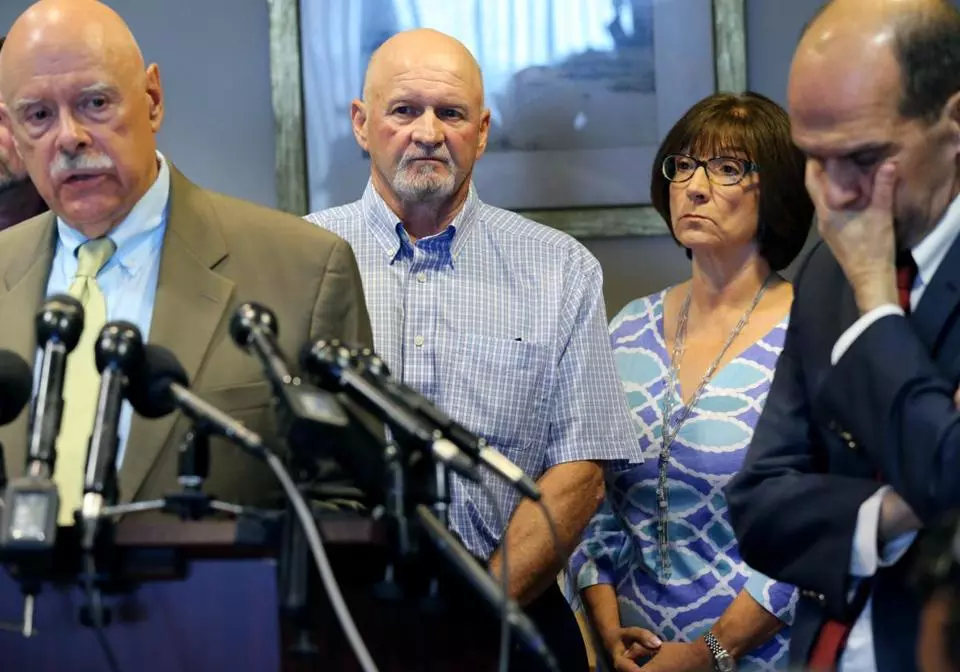‘i’m Concerned He’s Going to Abuse Again’: Those Who Say Priest Abused Them Criticize His Release
By Michael Levenson
When John Harris was 21 and just coming out as gay, a professor at the University of Lowell referred him to a priest named Paul R. Shanley, who had started a retreat for gay people called the Exodus Center, in Milton. There, he said, Shanley raped him in February 1979. He was one of scores of alleged victims of the notorious former “street priest” whose lives were irreparably damaged by sexual abuse at the hands of someone they trusted. On Wednesday, Harris stood with other victims and denounced the doctors who cleared the 86-year-old defrocked priest for release from prison Friday, finding that he was no longer a threat to the public after 12 years behind bars for raping a young boy at a Newton church in the early 1980s. By turns angry, solemn, and resolved, the victims and their attorneys demanded changes in the standards used to determine whether a prisoner is a “sexually dangerous person” who can be held behind bars even after his or her sentence is completed. They also said they want the public to be on notice that they believe Shanley remains a sexual predator, despite the doctors’ opinion. “This is a guy, Shanley, who has manipulated the system, the church, and the public, and knows how to manipulate people,” Harris, 59, said calmly at a press conference at a downtown Boston law office. “I’m concerned he’s going to abuse again.” Shanley was one of the most reviled priests to emerge during the sexual abuse crisis in the Catholic Church more than a decade ago. He preyed, according to victims’ attorneys, on children as young as 6 and adults as old as in their 50s. But he was notorious for abusing teenagers who came to him for counseling because they had run away from home, were confused about their sexuality, or were struggling with drugs. “If Paul Shanley doesn’t qualify as a sexually dangerous person, then nobody will ever qualify,” said Carmen L. Durso, an attorney who represented many Shanley victims in civil claims against the Catholic Church. Middlesex District Attorney Marian T. Ryan’s office, which sought to have Shanley committed to prison after his sentence was completed, said the doctors’ reports that thwarted the effort have not been finalized and are not public. As such, nothing is known about the basis for their decision. But Dr. Paul Zeizel, a psychologist who has evaluated sexually dangerous persons, said Shanley’s age was probably a key factor. “What I can say is most 86-year-old men usually have very nominal sex drive — it doesn’t mean he doesn’t have one — and probably would not be considered sexually dangerous,” Zeizel said. Dr. Martin Kafka, a psychiatrist who has worked with sex offenders for 30 years, agreed. He said recidivism rates for sex offenders fall sharply after age 60 and continue to plummet as they age and their serum testosterone levels decline. Pedophiles, however, have higher recidivism rates than other sex offenders, he said. “One of the reasons you would want to keep Shanley [behind bars] is he was a child molester of boys. That is a factor,” Kafka said. “But the fact that he’s in his late 80s would be a very important factor, as well.” Mitchell Garabedian, an attorney who represented dozens of Shanley’s victims, roundly rejected the notion that the former priest’s age means he is no longer a threat to the public. “Age is not a factor when it comes to a pedophile priest victimizing innocent children,” Garabedian said. “It’s not necessarily about sex. It’s about control.” In general, Kafka said, mental health professionals who conduct sexual dangerousness evaluations consider a wide range of factors, including the offender’s record in prison and their mental health and criminal histories. Most doctors also use a 10-item assessment tool called the Static-99R to determine whether a sex offender is likely to offend again. The tool evaluates offenders based on such risk factors as the their age at the time of release, whether they have ever lived with a lover for at least two years, and whether they have a history of violence. Prosecutors can then use the evaluations to try to prove in court that the offender meets the legal definition of a sexually dangerous person. Massachusetts law says the offender must have “a mental abnormality or personality disorder which makes such person likely to engage in sexual offenses if not confined to a secure facility.” “Nobody wants to be wrong in predicting dangerousness, so we, as a group, tend to make conservative predictions,” Kafka said. “So if these two examiners feel he’s at a low risk and should be released, I have to put some trust in their examinations.” After he is released from a medium-security prison in Bridgewater on Friday, Shanley will be monitored by the state Probation Department for the next 10 years and has been ordered to have no contact with children under the age of 16. He will have to register as a sex offender. But the fact that he will be free is a blow to victims and their families. Rodney Ford, whose son, Gregory, was allegedly molested by Shanley in the 1990s, said if he ran into the former priest on the street, he would feel tempted to hurt him. “I have those thoughts,” he said. “What father wouldn’t have those thoughts [about someone] that destroyed his son? I have to be real and tell you that.”
|
.
Any original material on these pages is copyright © BishopAccountability.org 2004. Reproduce freely with attribution.
